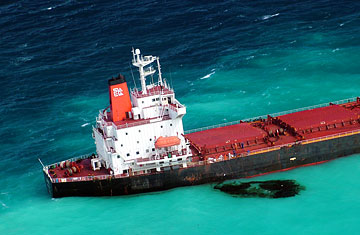
The Chinese-registered coal tanker Shen Neng 1, aground on a reef east of Great Keppel Island, Australia, on April 4, 2010
Environmentalists and politicians alike went wild this month when a Chinese shipping vessel plowed at full speed into the delicate corals of Australia's protected Great Barrier Reef Marine Park. Damage to the Douglas Shoal, one of the 2,900 reefs in the 133,000-sq.-mi. (350,000 sq km) marine park, covered an area equivalent to five football fields, leaving a vast, empty plain of sand where a healthy coral community had hosted a variety of unique plants and animals.
But marine biologists are wondering if the worst is yet to come. Queensland, the nearest Australian state to the offshore UNESCO heritage site, is experiencing a liquefied-natural-gas boom. Despite being the largest marine conservation park in the world, the Great Barrier Reef is an increasingly busy passageway connecting bulk carriers to those natural resources; a deal was recently signed involving the Chinese purchase of $55 billion worth of gas from the area. Richard Leck, the marine-policy manager at WWF Australia, says unless changes are made to the current system, a bigger accident is unavoidable. "It's pretty obvious that the management of the shipping system is not up to the job," says Leck. "Every time an incident like this happens, politicians and the general public take a deep breath in and cross our fingers. We hope that this isn't going to be the time when there is a massive oil spill."
On April 3, the Shen Neng 1, a 755-ft. (230 m) bulk carrier, left the Australian town of Gladstone for Bayuquan, China, around midday. The vessel, belonging to Shenzen Energy Transport Co. Ltd., carried 65,000 tons of coal and its tank contained 975 tons of fuel oil. Five hours into its homeward journey, still near the Queensland coast, the ship strayed 15 nautical miles off the well-worn route over the reef, running aground on the Douglas Shoal. The Shen Neng 1 is headed back to Gladstone for repairs.
The scale of destruction is currently being evaluated by the Australian Institute of Marine Science (AIMS), which sent a team of investigators to the site on April 15. What is known is that currents and tides pushed the boat through the reef, leaving a 10,000 ft. by 850-ft. (3,000 m by 260 m) scar. Between two and four tons (equivalent to between 2,000 and 5,000 liters) of heavy fuel oil have seeped into pristine parts of the area, and some of the oil has washed ashore at two nearby islands. Scientists have yet to measure the toxicity of the ship's antifouling paint, which prevents marine life from flourishing on its hull and could stunt regrowth in coral populations, that scraped onto parts of the smashed coral. "There are areas of the seabed that have been pulverized," says David Wachenfeld of the Great Barrier Reef Marine Park Authority. "It's a white, flat plane of sand and crushed coral rubble. You have to look at either side of the area to imagine that there was something there before."
In the past decade, there have been three major ship groundings at the Great Barrier Reef, but grounded ships only add to the trouble of the beleaguered marine park. Rising sea temperatures have resulted in two incidents of mass coral bleaching, in which swaths of the delicate organisms die off, in 1998 and 2002. Trawl fishing, which is still legal at the Great Barrier Reef, has damaged parts of the sea floor and resulted in many untargeted species being caught, and sediments entering the water from nearby agricultural properties have led to a host of different problems, including outbreaks of the crown-of-thorns starfish, a creature that feeds on coral. Peter Harrison, the director of marine studies at Southern Cross University in Lismore, believes the reef is in a perpetual state of recuperation. "It's a mosaic of different corals and reef communities that are in various stages of recovery from disturbances of one or more of those types of events."
Others paint a far gloomier picture. "In 1998, one of the warmest years on record, 16% of the world's coral died," says Terry Hughes, the director of the ARC Centre of Excellence for Coral Reef Studies at James Cook University in Townsville. "That was a real disaster. The [Shen Neng 1] ship grounding, in the scheme of things, is not a major incident. It's bad if you happen to be one of the corals the ship parked itself on, but it's tiny in the face of the real problem: global warming ... A designated retirement plan for the coal industry is the start to a solution."
In the meantime, as chances of another, larger oil spill look likely to rise with the ship traffic, the government — and ship captains — can do better, says Leck of the WWF. "I think a lot of people were shocked that the authorities had no idea that the [Shen Neng 1] steered 15 nautical miles off course," he says. Leck would like to see a vessel-tracking system that covers the entire area of the reef implemented, with every ship passing through the area having a compulsory marine pilot on board to take over from the captain throughout the whole Great Barrier Reef. This request may be granted, as tougher tracking measures for ships entering the Great Barrier Reef will be put into place from July 2011. Then, it will be compulsory for vessels in the area to regularly report their movements.
The Shen Neng 1 master, Wang Jichang, has been charged with liability for a vessel causing damage to a marine park, and the ship's first officer, Wang Xuegang, who was in control of the boat when it hit Douglas Shoal, could face a three-year prison term and a $205,000 fine. Wang Xuegang was reported to have had only 2½ hours of broken sleep over the 37-hour period before the crash.
